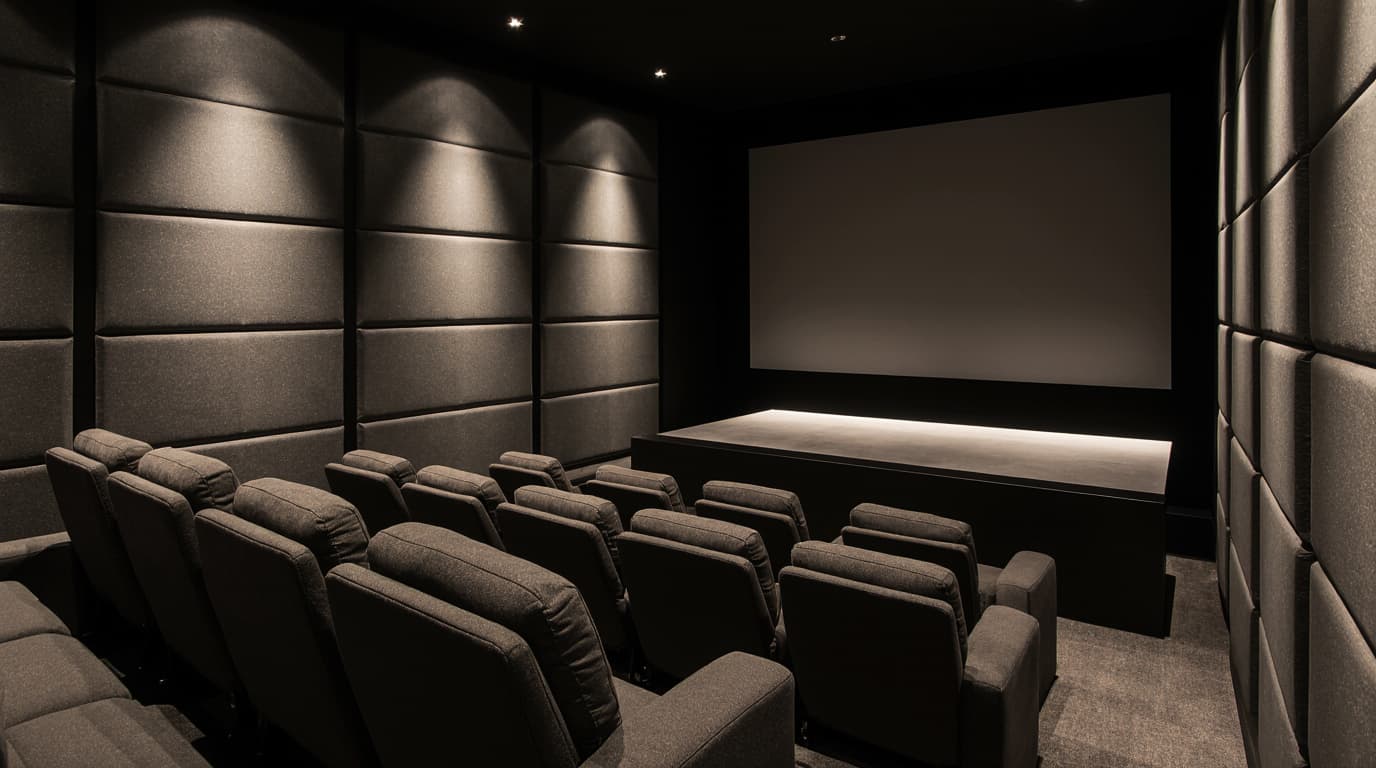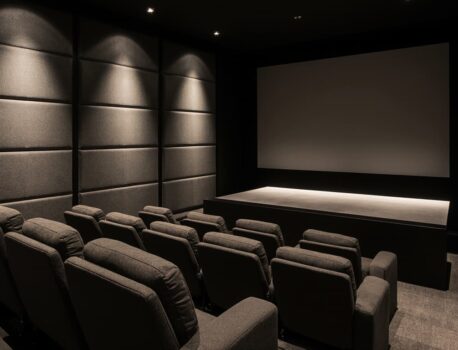In a world flooded with noise, silence has become a luxury — and in documentary cinema, a necessity. The ability to fully immerse in a story, especially one rooted in reality, depends not only on the visuals or the narrative but on how the story sounds. Every breath, every ambient note, and every moment of silence has the potential to carry emotional weight. When a space is designed for sound as intentionally as it’s designed for sight, a film doesn’t just play — it resonates.
That’s why screening environments, especially for documentaries, must do more than house an audience. They must protect the experience. This means shielding it from the chaos of the outside world and curating the internal acoustics with care. Done right, the room becomes part of the storytelling. Done poorly, it becomes a distraction.
Soundproofing plays a critical role here. Whether it’s a grassroots cinema or a high-end private screening room, quality acoustic isolation defines how a film will be heard — and felt. Companies like New York Soundproofing have made it possible to transform ordinary urban rooms into sonically isolated sanctuaries, where outside interference fades and the audio mix takes center stage. Their approach, focused on real-world results, has influenced not just media professionals but also architects and cultural institutions looking to create better environments for listening.
Why Sound Matters More Than Ever in Documentary Screening Spaces
Documentaries often carry stories that require quiet. They live in the subtleties — an old man’s whisper, the echo of a street corner, the fragile pause in a survivor’s voice. When these details are swallowed by HVAC rumble or traffic bleed, something vital is lost. And in many cases, there’s no second take.
In spaces like Cinema Jenin — a beautifully restored cultural venue on the West Bank — attention to sound design isn’t just about luxury, it’s about respect. Respect for the story, for the filmmakers, and for the community that gathers to watch. Cinema Jenin was built with the intention of plush seating, gallery space, and even a library supported by the Goethe-Institut. But it’s the atmosphere of focus, of stillness, that elevates it. That atmosphere is only possible through thoughtful acoustic design.
Across the globe, independent cinemas and pop-up screening venues are emerging in the least likely places: old warehouses, church basements, and former retail spaces. These sites often begin with poor acoustic characteristics and plenty of ambient noise. But with smart upgrades — including wall isolation, bass traps, and floating ceilings — they can become excellent viewing spaces. Soundproofing, in these cases, isn’t just technical; it’s transformational.
How Urban Noise Challenges the Authenticity of the Viewing Experience
City noise is persistent. It’s not just loud, it’s unpredictable — sirens, horns, subway tremors, neighbors above. For viewers trying to stay with a story, these interruptions can tear them out of the emotional space of a film. This is especially damaging in documentaries, where authenticity and subtlety are key. A poorly soundproofed room becomes a battleground for attention.
For filmmakers, that’s not acceptable. They spend months, even years, crafting soundtracks that support the raw intimacy of their footage. When that careful soundscape is masked by external noise, the film loses power. Screening venues that fail to address acoustic isolation often become places where good films fall flat.
It’s not about total silence — it’s about acoustic control. The ability to manage what the audience hears, and what it doesn’t. And that control starts with the space itself.
Key Elements That Define an Effective Screening Room
Acoustic isolation as the foundation
First comes the physical barrier: separating the room from the world outside. This means double walls, decoupled ceilings, soundproof doors, and vibration control. Without this layer of protection, even the best audio system can’t deliver a clean experience.
It’s not just about blocking sound, it’s about containing it. In a well-isolated room, even a whisper can be heard clearly — without turning up the volume or overprocessing the mix.
Absorption versus diffusion in room tuning
Once isolation is in place, the interior tuning begins. Absorption materials (like acoustic panels, thick curtains, or foam) reduce echo and control reflections. Diffusers, on the other hand, scatter sound in ways that preserve energy but avoid harsh spots or dead zones.
Both elements are necessary. A room with only absorption can feel flat and lifeless, while a space with no absorption is likely to be echoey and chaotic. Striking the right balance takes experience — and a solid understanding of how humans actually listen.
Seating, spacing, and the physical layout of silence
Design doesn’t stop with the walls. The layout of the room — how the seats are spaced, what materials are used, how the floor reflects or absorbs sound — all play into the acoustic experience. Hard surfaces create bounce. Soft surfaces dampen it.
Even seating density matters. A full room absorbs more sound than an empty one. That’s why flexible acoustic tuning is key for multi-purpose screening spaces.
Learning from Cinemas That Got It Right
Some of the most impactful screening spaces in the world aren’t the biggest or the most high-tech — they’re the ones that get the fundamentals right. Cinema Jenin is one such example. Built in a politically and acoustically challenging environment, it still delivers a focused, immersive experience. That’s the result of good design, cultural intention, and careful attention to sound.
In New York, many independent cinemas and private studios operate inside dense, noisy urban blocks. They’ve had to get creative — layering floors, decoupling walls, using soundproofing techniques usually reserved for recording studios. These spaces serve not just filmmakers and cinephiles, but educators, community organizers, and artists who depend on sound clarity to communicate meaning.
This isn’t just about better film nights. It’s about access. Spaces that control noise are spaces where people can gather without distraction. They’re where emotion travels unfiltered, where silence can land heavy. Where a moment on screen actually has room to breathe.
That’s why many of these venues turn to trusted soundproofing experts to consult on renovations or new builds. Whether for a 30-seat microcinema or a cultural hub like Cinema Jenin, the blueprint starts with respect for the sound.
Designing for the Future of Storytelling in a Noisy World
The role of the screening room is shifting. It’s no longer just a place to watch — it’s a space where stories are processed, where communities reflect, where truth gets a chance to land without interruption. For documentaries, especially, that clarity is everything.
But the world isn’t getting quieter. Cities are expanding. Infrastructure is growing. Background noise has become the default, and attention is harder to hold than ever. That means screening rooms have to work harder to create controlled environments — not just visually, but acoustically.
Designers, filmmakers, and cultural curators are waking up to this reality. They’re building spaces that prioritize sound from the ground up. Not just installing better speakers or upgrading projectors, but shaping environments where the absence of noise becomes part of the experience.
There’s also a shift in how we think about silence. It’s not just the lack of sound. It’s a space of focus. Of listening. Of intimacy. And it has to be built with intention.
This future isn’t just for large institutions. With access to soundproofing knowledge and materials more widely available, small collectives, pop-up festivals, and local arts groups can now build their own cinematic sanctuaries. All it takes is care — and the will to protect the story.
The Responsibility of the Space
At the heart of all this is a simple idea: the environment matters. A story told in the wrong space doesn’t reach people the way it should. Every rattling vent, every honk outside the window, every footstep from the apartment above — it chips away at the emotional thread a filmmaker has spent months weaving.
This is where architecture becomes part of authorship. The walls, the floor, the layout — they become co-authors of the experience. When they’re neglected, stories suffer. When they’re respected, stories shine.
And the audience feels the difference. They may not know the materials used in the ceiling, or how many decibels were blocked by the door insulation, but they’ll know how the film made them feel. They’ll remember if they were pulled in or pushed out. They’ll remember the silence.
Creating Cinemas That Listen
At the end of the day, it’s not about building perfect rooms. It’s about building rooms that listen. Spaces that don’t compete with the film, but hold it. Spaces that treat stories with care, especially those told through real voices, hard truths, and fragile soundscapes.
Whether you’re building a nonprofit cinema in the West Bank, retrofitting a space in Brooklyn, or designing a small media room in your neighborhood library, the goal is the same: create a space where stories can speak — and be heard.
Silence is more than an absence. It’s a frame. A tool. A decision. And when used well, it makes everything else louder.

